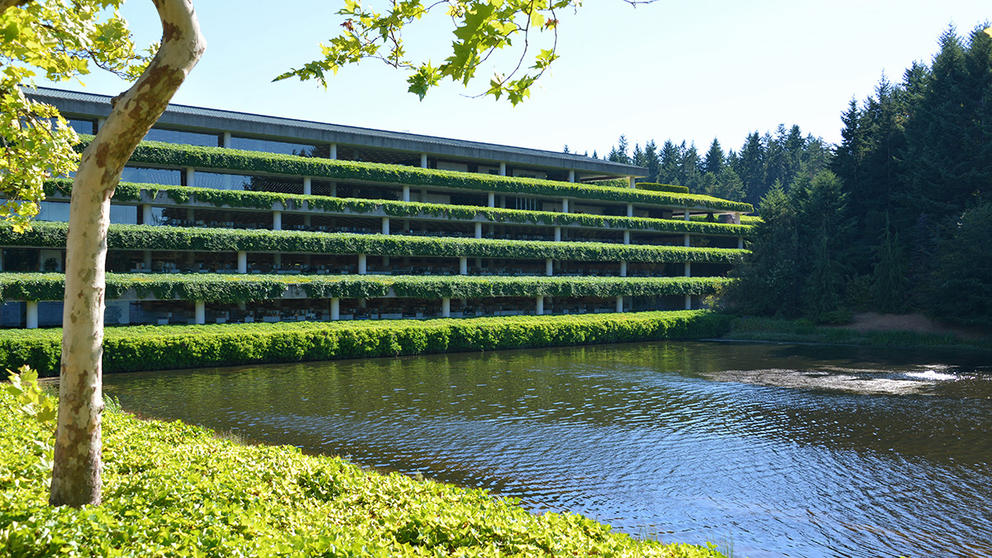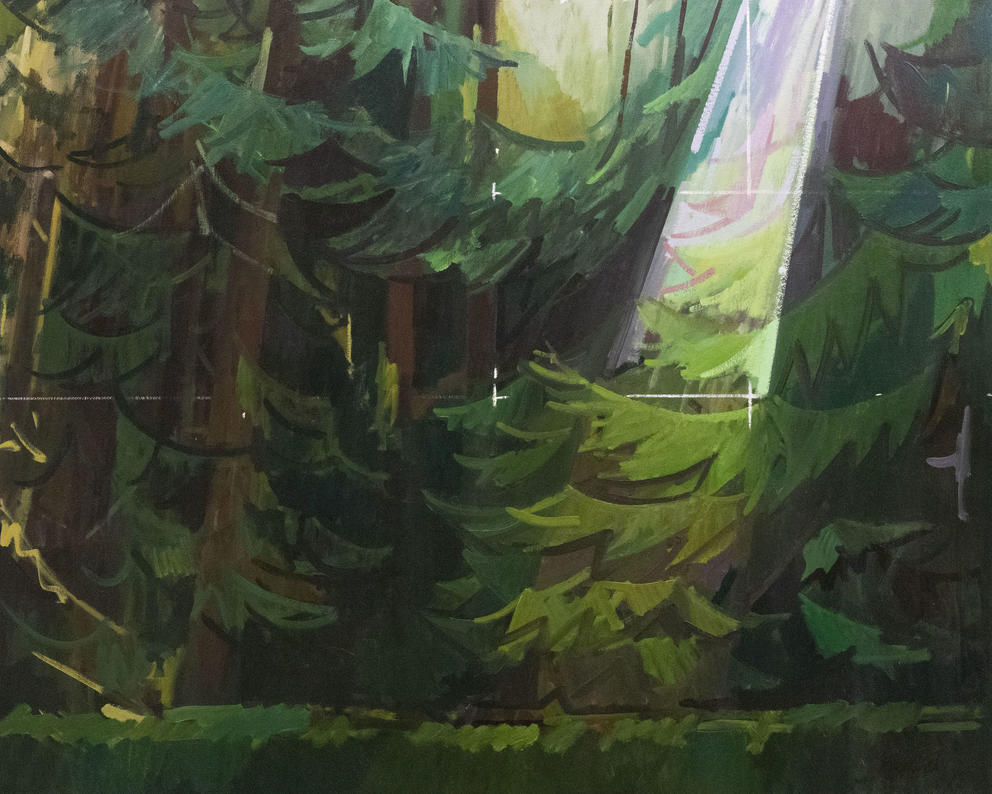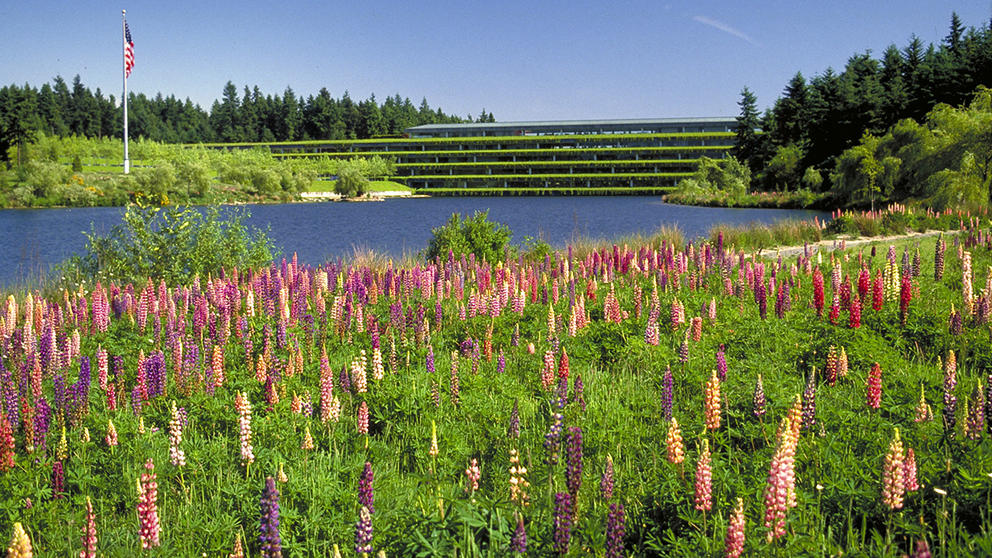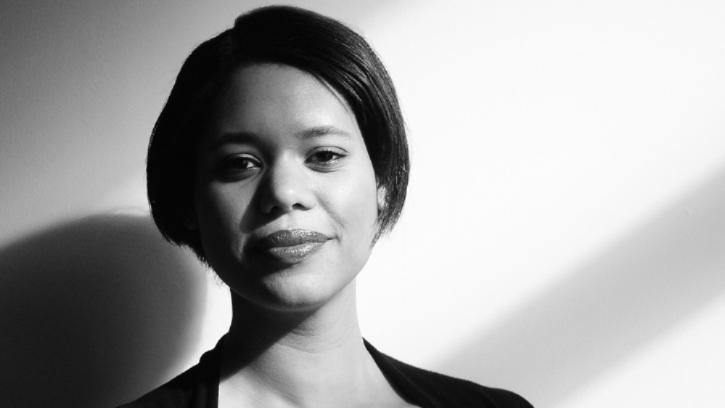While the Red Planet’s pocked and barren landscape might not inspire the kind of escape fantasies that, say, Cheap Old Houses on Instagram does (WARNING: rabbit hole), it exerts an irresistible allure. It’s Mars! The stuff of sci-fi stretching out before our eyes. I’ve spent a couple lunch breaks zooming into the high-def 360-degree panorama, looking for signs of life the scientists might have missed. Perhaps most fascinating to me is how familiar the rocky desert looks, just like a hardscrabble patch of earth.
ArtSea: Notes on Northwest Culture is Crosscut’s weekly arts & culture newsletter
This past weekend I explored more local terrain, on a mission to the Kitsap Peninsula. I touched down at Bainbridge Island Museum of Art, where Seattle artist Kimberly Trowbridge has a dreamy new solo show, Into the Garden (through May 9). These lush green oil paintings are the result of her residency at the historic Bloedel Reserve, also on Bainbridge (a visit to both makes a perfect pairing). Trowbridge, an expert in color theory, depicts the Edenic grounds of the preserve with a studied eye toward the endless depths of Northwest green: plush moss gardens, a grove of Douglas firs pierced with light, the bright surprise of camellia blossoms, the eerie emerald reflecting pool.
I’ve previously confessed a penchant for “moss porn,” and these paintings definitely qualify. But Trowbridge transports viewers into the verdant landscape not so much with realism — her brush marks are deliberately chunky, her figures geometric often to the point of cubist — as with a sensation that emanates from the environment, like the soft sweep of a fern against skin.
The artful impact of landscape was on my mind this week, thanks to the renewed effort to save the historic Weyerhaeuser campus in Federal Way. Built in 1971 as one of the first environmentally conscious corporate headquarters, it’s now threatened by development and has been designated by the national Cultural Landscape Foundation as “at-risk.” Even if you aren’t familiar with the site, you’ve likely noticed it while traveling southbound from Seattle on Interstate 5: the unusual, tiered white building nestled into a grassy vista. When I first spotted it, I remember wondering what is that place — supervillian’s lair? Lost civilization? Alien outpost?
Timber baron George H. Weyerhaeuser wanted his headquarters to blend in with the surrounding trees and wetlands. So architect Edward Charles Bassett designed a modernist “skyscraper on its side,” the ivy-laced open-plan offices nearly hidden amid the parklike landscape design by Peter Walker (who decades later designed the tree-lined 9/11 Memorial in New York City).
The Weyerhaeuser company sold the campus to Los Angeles-based Industrial Realty Group in 2016 and moved its headquarters to Pioneer Square. While the central building isn’t slated to be torn down (it’s for lease — and would make a spectacular destination arts center), Industrial Realty wants to build five warehouses, totaling 1.5 million square feet and requiring the removal of more than 100 acres of forested land.
National media has recently picked up on the preservation efforts of local advocacy group Save Weyerhaeuser Campus (see recent features in The New York Times and Fast Company), which is waging legal battles not to stop the development entirely, but to mitigate its asphalt footprint. The Puyallup Tribe has registered concerns about environmental impact, as the campus sits on ancestral land and the reservation is nearby. And George Weyerhaeuser himself, now 94 and no longer involved in the company, has contributed to the preservation campaign.
As a fan of the site and neighboring Pacific Bonsai Museum (where the powerful WWII bonsai exhibit continues), I’m hoping the aesthetics of this far-out landscape can be maintained for future explorers.
Another cool thing about the new Mars mission: We can hear what it sounds like on the surface. NASA is sharing audio clips from Perseverance, and while the first one is perhaps less than revelatory — a few gusts of wind thrumming against the microphone — it’s nonetheless captivating to hear the far-flung soundscape.
Among the closer-flung sonic landscapes worth bending your ear toward this week:
The U.S. premiere of up-and-coming composer Hannah Kendall’s Kanashibari (Seattle Symphony Orchestra livestream Feb. 25 at 7:30 p.m., online through March 4). The New York City musician based this piece on the physical phenomenon of sleep paralysis — and the fight to get your body to align with your mind in times of stress. “I found it interesting that most automatically associate sleep with being calm and restful,” she writes on Soundcloud, “when in fact it is often a disturbed experience for many of us.”
This Land is the expressive new album from brass quintet The Westerlies (who, like the wind, moved from Seattle to New York). These phenomenal young musicians create walls of soft sound with stacked rounds and intertwining lines. Here, the group teams up with vocalist Theo Bleckmann on fresh new arrangements of old protest songs, including Woody Guthrie’s “Tear the Fascists Down” and a haunting version of the 1970s “Look for the Union Label” jingle.
And finally (tonight!), a streaming music event from Keep Music Live, the local folks working to keep struggling music venues afloat. This installment of the “Green Room Sessions” celebrates Black History Month via local talent, including Sir Mix-A-Lot, Eva Walker of The Black Tones, Adra Boo, T.S The Solution and Benjamin Hunter (Feb. 25 at 7:30 p.m. Free, with donations encouraged).
While music concerts may still be virtual for a time, they can still transport us out of our homes and into other realms.
Get the latest in local arts and culture
This weekly newsletter brings arts news and cultural events straight to your inbox.









